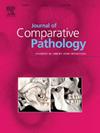Spontaneous ependymoma in a free-ranging juvenile black-horned capuchin (Sapajus nigritus)
IF 0.8
4区 农林科学
Q4 PATHOLOGY
引用次数: 0
Abstract
A young free-ranging black-horned capuchin (Sapajus nigritus) with a history of ataxia, anisocoria, diminished threat and pupil reflexes and increased cranial circumference was referred for evaluation to the Medicine and Wildlife Conservation Section, Federal University of Paraná, Paraná, Brazil. Due to the clinical presentation and radiographic findings of hydrocephalus, euthanasia was performed. Necropsy revealed a dark red mass (1.5 × 1.8 cm) in the region of the third ventricle and marked dilation of the lateral ventricles. Histopathological findings were characterized by proliferation of ciliated round cells with eosinophilic cytoplasm, as well as the formation of ependymal rosettes and pseudorosettes. In some areas the cells contained brown cytoplasmic pigment, which stained with Fontana-Masson. The neoplastic cells were immunoreactive for glial fibrillary acidic protein and negative for pancytokeratin. Considering the anatomopathological and immunohistochemical findings, the diagnosis was ependymoma grade II with melanocytic features, which is the first report of this neoplasm in any member of the genus Sapajus.
一只自由放养的黑角卷尾猴(Sapajus nigritus)幼年自发性脑外膜瘤。
巴西巴拉那州巴拉那联邦大学医学与野生动物保护科转诊了一只年轻的散养黑角卷尾猴(Sapajus nigritus),该动物曾出现共济失调、失神、威胁反射和瞳孔反射减弱以及颅围增大等症状。由于其临床表现和影像学检查结果均为脑积水,因此对其实施了安乐术。解剖发现,第三脑室区域有一个暗红色肿块(1.5 × 1.8 厘米),侧脑室明显扩张。组织病理学检查结果显示,纤毛圆形细胞增生,胞浆嗜酸性,并形成上皮细胞轮纹和假轮纹。某些区域的细胞含有棕色胞质色素,并用 Fontana-Masson 染色。肿瘤细胞对神经胶质纤维酸性蛋白有免疫反应,而对泛影角蛋白呈阴性反应。考虑到解剖病理和免疫组化结果,诊断结果为具有黑素细胞特征的上皮瘤 II 级,这是首次报道萨帕茹属的任何成员患有这种肿瘤。
本文章由计算机程序翻译,如有差异,请以英文原文为准。
求助全文
约1分钟内获得全文
求助全文
来源期刊
CiteScore
1.60
自引率
0.00%
发文量
208
审稿时长
50 days
期刊介绍:
The Journal of Comparative Pathology is an International, English language, peer-reviewed journal which publishes full length articles, short papers and review articles of high scientific quality on all aspects of the pathology of the diseases of domesticated and other vertebrate animals.
Articles on human diseases are also included if they present features of special interest when viewed against the general background of vertebrate pathology.

 求助内容:
求助内容: 应助结果提醒方式:
应助结果提醒方式:


